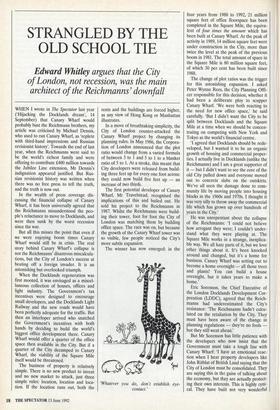STRANGLED BY THE OLD SCHOOL TIE
Edward Whitley argues that the City
of London, not recession, was the main architect of the Reichmanns' downfall
WHEN I wrote in The Spectator last year (`Hijacking the Docklands dream', 14 September) that Canary Wharf would probably bust the Reichmann brothers, my article was criticised by Michael Dennis, who used to run Canary Wharf, as 'replete with third-hand impressions and Russian revisionist history'. Towards the end of last year, when the Reichmanns were said to be the world's richest family and were offering to contribute £400 million towards the Jubilee Line extension, Mr Dennis's indignation appeared justified. But Rus- sian revisionist history was written when there was no free press to tell the truth, and the truth is now out.
In the wealth of press coverage dis- cussing the financial collapse of Canary Wharf, it has been universally agreed that the Reichmanns misunderstood the peo- ple's reluctance to move to Docklands, and were then sunk by the worst recession since the war.
But all this misses the point that even if we were enjoying boom times Canary Wharf would still be in crisis. The real story behind Canary Wharf's collapse is not the Reichmanns' disastrous miscalcula- tions, but the City of London's success at beating off a foreign invader. It is an astonishing but overlooked triumph.
When the Docklands regeneration was first mooted, it was envisaged as a miscel- laneous collection of houses, offices and light industry. The Government's tax incentives were designed to encourage small developers, and the Docklands Light Railway and the new roads would have been perfectly adequate for the traffic. But then an interloper arrived who snatched the Government's incentives with both hands by deciding to build the world's biggest office development there. Canary Wharf would offer a quarter of the office space then available in the City. But if a quarter of the City decamped to Canary Wharf, the viability of the Square Mile itself would be threatened.
The business of property is relatively simple. There is no new product to invent and no new market to attack, just three simple rules: location, location and loca- tion. If the location runs out, both the rents and the buildings are forced higher, as any view of Hong Kong or Manhattan illustrates.
In a move of breathtaking simplicity, the City of London counter-attacked the Canary Wharf project by changing its planning rules. In May 1986, the Corpora- tion of London announced that the plot ratio would change from a varied formula of between 3 to 1 and 5 to 1 to a blanket ratio of 5 to 1. At a stroke, this meant that City developers were released from build- ing three feet up for every one foot across: they could now build five feet up — an increase of two thirds.
The first potential developer of Canary Wharf, Mr Travelstead, recognised the implications of this and bailed out. He sold his project to the Reichmanns in 1987. Whilst the Reichmanns were build- ing their tower, foot for foot the City of London was matching them by building office space. The race was on, but because the growth of the Canary Wharf tower was so visible, few people noticed the City's more subtle expansion.
The winner has now emerged: in the 'Whatever you do, don't establish eye- four years from 1988 to 1992, 21 million square feet of office floorspace has been completed in the Square Mile, the equiva- lent of four times the amount which has been built at Canary Wharf. At the peak of activity in 1989, 14 million square feet were under construction in the City, more than twice the level at the peak of the previous boom in 1981. The total amount of space in the Square Mile is 80 million square feet, of which 30 per cent has been built since 1988.
The change of plot ratios was the trigger for this astonishing expansion. I asked Peter Wynne Rees, the City Planning Offi- cer responsible for this decision, whether it had been a deliberate ploy to scupper Canary Wharf. 'We were both reacting to the need for new office space,' he said carefully. 'But I didn't want the City to be split between Docklands and the Square Mile at a time when we should be concen- trating on competing with New York and Tokyo as the world's financial centre.
'I agreed that Docklands should be rede- veloped, but I wanted it to be an organic growth of housing and commercial proper- ties. I actually live in Docklands (unlike the Reichmanns) and I am a great supporter of it — but I didn't want to see the core of the old City pulled down and everyone moved out to concrete slabs on the outskirts. We've all seen the damage done to com- munity life by moving people into housing blocks in the 1960s and 1970s. I thought it was very silly to throw away the commercial life which has grown up over hundreds of years in the City.'
He was unrepentant about the collapse of the Reichmanns: 'I could not believe how arrogant they were; I couldn't under- stand what they were playing at. The Square Mile works in a strange, inexplica- ble way. We all hate parts of it, but we love other things about it. It's been knocked around and changed, but it's a home for business. Canary Wharf was setting out to become a home overnight — all those trees and plants! You can build a house overnight, but it takes years to make a home.'
Eric Sorenson, the Chief Executive of the London Docklands Development Cor- poration (LDDC), agreed that the Reich- manns had underestimated the City's resistance: 'The Reichmanns hadn't calcu- lated on the retaliation by the City. They must have been aware of the change in planning regulations — they're no fools hut they still went ahead.'
But Mr Sorenson has little patience with the developers who now insist that the Government must take a tough line with Canary Wharf: 'I have an emotional reac- tion when I hear property developers like John Ritblat of British Land saying that the City of London must be consolidated. They are saying this in the guise of talking about the economy, but they are actually protect- ing their own interests. This is highly cyni- cal. They have built not very wonderful buildings which they want to rent out as desperately as the Reichmanns.
The Reichmanns have built Canary Wharf to a superb standard. They are excellent offices in a marvellous setting and with the Jubilee Line they will have good access. They are responsible for a steep change in the quality of offices, and they should get credit for that.'
But he offered cold comfort for Canary Wharfs future: 'I don't know whether there is any reason for all the space to be taken up. It could be like Houston, Texas, where vast skyscrapers have stood empty for ten years. They too were fuelled by the government giving away tax breaks to encourage development.'
The cost of trouncing Canary Wharf has been a massive over-supply of space in the City — about a quarter of all office space in the City is vacant. Yet, in the long run, this should not be a disaster because it means that people will stay in the City until all the slack is taken up. When the IRA blew up one of the biggest City tower blocks, Commercial Union tower, one Fri- day night, the entire 2,500 staff were relo- cated in the City by Monday morning. If the IRA blew up Canary Wharf tower, which has attracted just 1,500 tenants, it would be a sad loss to the London skyline but not a great problem for the property market.



















































 Previous page
Previous page